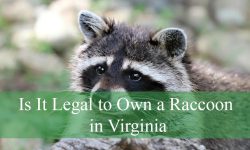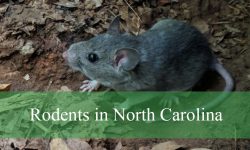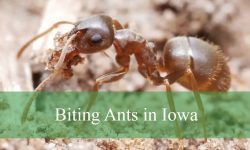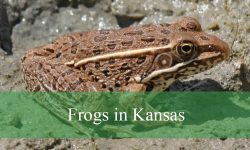Across Colorado’s range of environments, from wooded foothills to wide-open plains, a striking assortment of yellow birds can be found. These bright species can be found darting through willows, singing from fence posts, or visiting backyard feeders throughout the seasons. Their vivid plumage and cheerful songs make them favorites among bird enthusiasts.
Many of these birds arrive during spring migration, while others spend the entire summer nesting across the state. Each species offers something unique, whether it’s a striking mask, a sweet warble, or surprising feeding habits. This guide features 29 yellow birds commonly spotted in Colorado, complete with identification details, habitat preferences, and fun facts to enhance your next birdwatching outing.
Common Yellow Birds Found in Colorado
Lesser Goldfinch
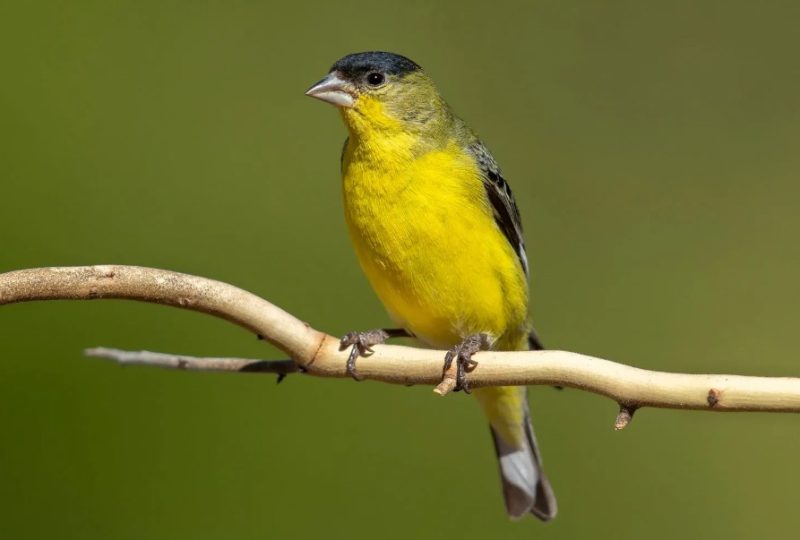
The Lesser Goldfinch (Spinus psaltria) is a small, energetic bird featuring a bright yellow underside and olive-black back in the western form, with some variation toward all-black upperparts in other regions. Its short, conical bill and notched tail are distinctive. It is slightly smaller than the American Goldfinch, measuring just 3.5 to 4.3 inches in length with a wingspan around 8 inches.
These goldfinches are found in foothills, open woodlands, and suburban areas across Colorado, especially in the warmer months. They flock to seed-producing plants like sunflowers and thistles and often visit feeders with nyjer or sunflower seeds. Lesser Goldfinches are very social and often move in small flocks, chattering with a complex mix of high-pitched notes and mimicry.
Interestingly, studies have shown that Lesser Goldfinches in different regions mimic the songs of other birds, including jays, wrens, and warblers. Their musical diversity makes them one of the most vocal small birds in Colorado’s dry and brushy habitats.
American Goldfinch
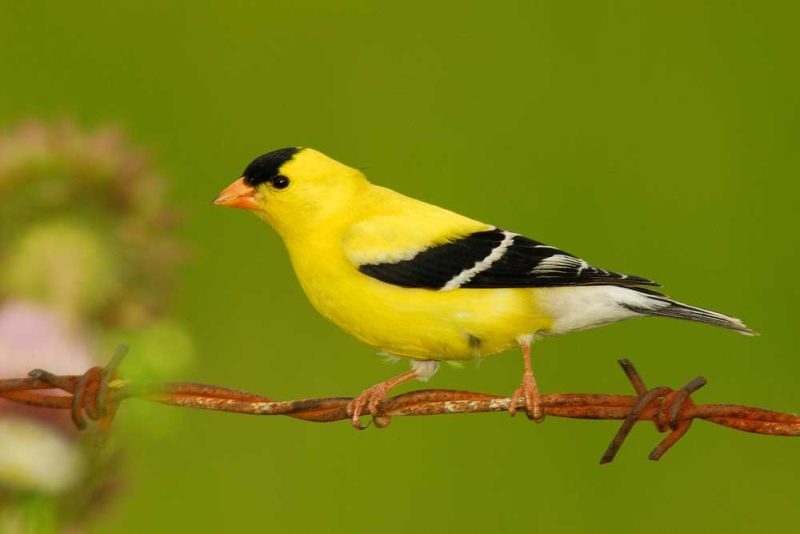
The American Goldfinch (Spinus tristis) is a small, brightly colored bird recognized for its vivid yellow plumage in males during the breeding season, contrasted by a black forehead and black wings with white markings. Females and winter males appear more muted, with olive or dull yellow tones. This finch is about 4.3 to 5.1 inches long with a wingspan of up to 8.7 inches, and it has a conical bill ideal for seed eating.
In Colorado, American Goldfinches are often found in weedy fields, suburban gardens, and open woodlands. They are granivores, relying heavily on seeds from thistles, sunflowers, and dandelions. They are one of the few bird species that breed later in the summer, timing their nesting to the peak of seed abundance. Their flight is undulating and accompanied by a cheerful “per-chick-o-ree” call.
A fun fact about American Goldfinches is that they undergo a complete molt twice a year—the only finch in North America known to do so. This gives them a striking seasonal transformation, turning from dull to dazzling yellow by late spring, which adds to their charm in Colorado’s sunny landscapes.
Cedar Waxwing
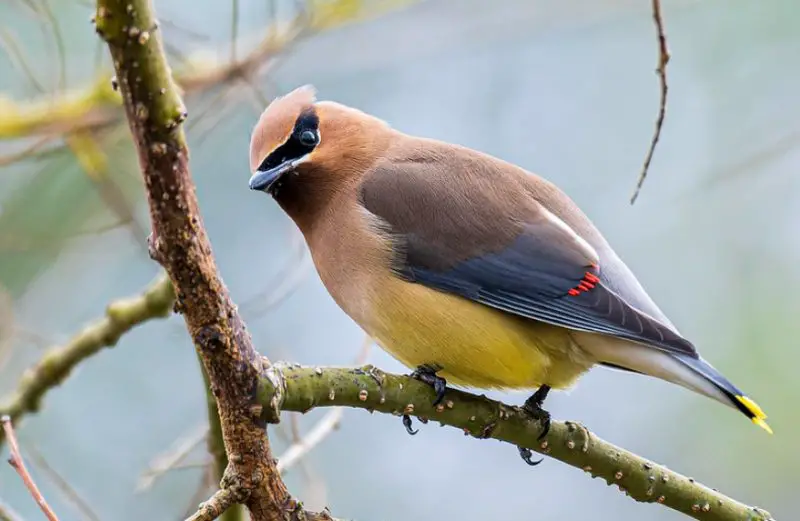
The Cedar Waxwing (Bombycilla cedrorum) is a sleek, medium-sized bird known for its silky plumage, pale yellow belly, and distinctive yellow-tipped tail. Its brownish-gray body and crest, along with a black mask and bright red wax-like tips on its wing feathers, give it a unique, polished appearance. Adults are typically 6.3 to 8.3 inches long with a wingspan of around 12 inches.
In Colorado, Cedar Waxwings are highly nomadic and travel in flocks across woodlands, river edges, and residential areas, especially where fruiting trees and shrubs are abundant. Their diet is primarily composed of fruits and berries, especially in fall and winter, but they also catch flying insects in summer. These birds are known for their social behavior, often passing berries to one another in courtship rituals.
One interesting fact about Cedar Waxwings is that their tail-tip color can change depending on their diet. Birds that consume berries high in certain pigments may develop orange tail tips instead of the usual yellow—a visual cue to their fruit-filled lifestyle.
Evening Grosbeak
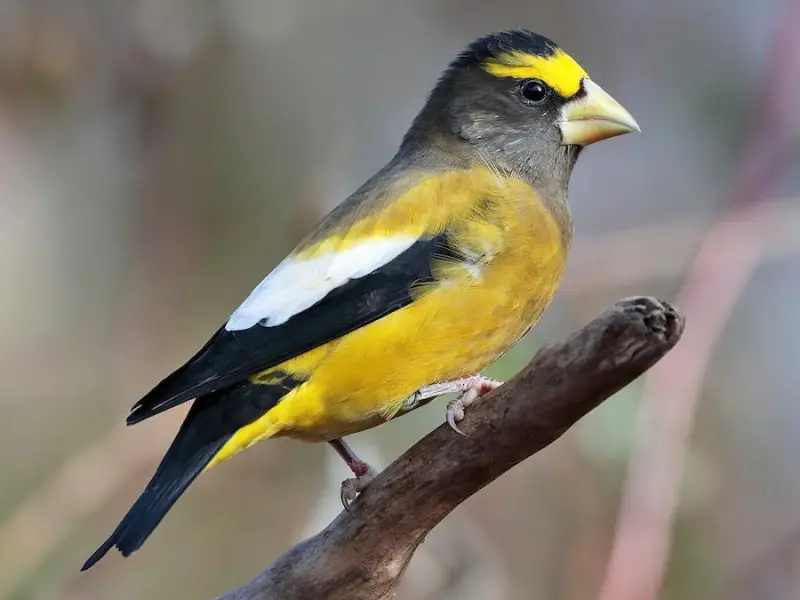
The Evening Grosbeak (Coccothraustes vespertinus) is a chunky, robust finch with a thick, pale bill and striking plumage. Males display a bold yellow body, black wings with white patches, and a rich brown head with a bright yellow eyebrow. Females are grayer, but still show hints of yellow and white. These birds average around 6.3 to 8.7 inches in length, with a wingspan nearing 14 inches.
This species is seen in Colorado’s coniferous forests, especially in the mountains, but may also descend to lower elevations during irruption years. Evening Grosbeaks feed primarily on seeds, especially from spruce, maple, and ash trees, and will visit feeders offering sunflower seeds. Their powerful bill is capable of cracking even the toughest seeds and tree buds.
Evening Grosbeaks are known for their unpredictable migration patterns. Some winters they appear in large numbers throughout Colorado, while in other years, they may be nearly absent. Their sudden appearances at backyard feeders are a welcome surprise for many birdwatchers.
Western Meadowlark
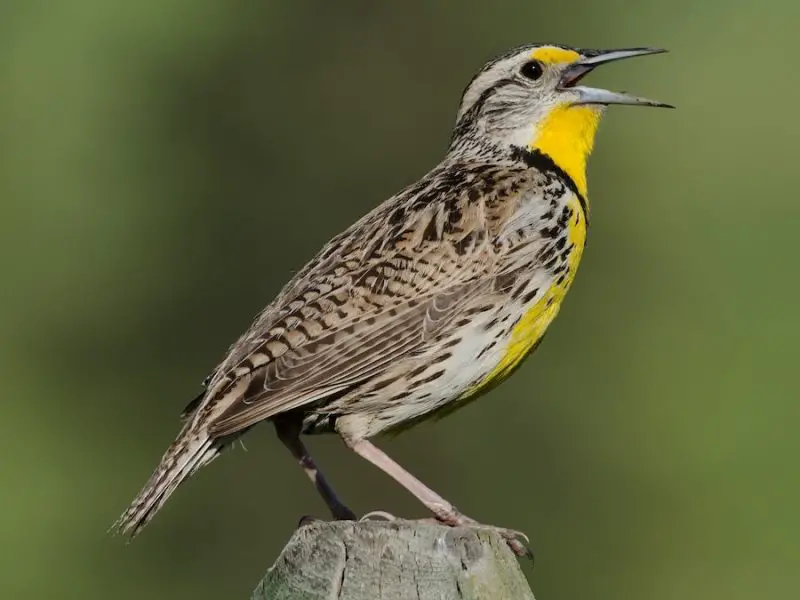
The Western Meadowlark (Sturnella neglecta) is a medium-sized songbird with a brilliant yellow underside marked by a bold black V on the chest. Its back is mottled brown and white, offering camouflage in grasslands. With a length of 6.3 to 10.2 inches and a wingspan of about 16 inches, this bird is both striking and well-adapted for open-country living.
A familiar presence across Colorado’s prairies and farmlands, the Western Meadowlark prefers wide open fields with tall grasses. It feeds on insects such as beetles, grasshoppers, and caterpillars during the warmer months, switching to seeds and grains in the winter. It builds ground nests hidden in dense grass, often with a roof made of woven stems.
The Western Meadowlark is the state bird of six U.S. states, including Kansas and Nebraska, but not Colorado—though it’s very common there. Its flute-like song, often heard ringing out from fence posts or shrubs, is considered one of the most beautiful bird songs in North America.
Yellow Warbler

The Yellow Warbler (Setophaga petechia) is a bright yellow songbird with golden plumage and faint reddish streaks on the chest in males. This small bird measures about 4.7 to 5.1 inches long, with a wingspan of around 7 inches. Its rounded head, black eyes, and cheerful song make it easy to recognize in shrubby and wetland habitats.
Yellow Warblers migrate through and nest in many parts of Colorado during spring and summer, particularly near streams, marshes, and willow thickets. They forage by flitting through branches, gleaning insects like caterpillars, beetles, and flies. Their nests are often carefully woven into shrubs and small trees, lined with plant down and animal hair.
A fascinating aspect of Yellow Warbler behavior is their response to parasitic cowbird eggs. If a Brown-headed Cowbird lays an egg in their nest, Yellow Warblers may build a new nest layer over it, sometimes creating multiple layers—like a bird version of building a second floor over a problem!
Western Kingbird
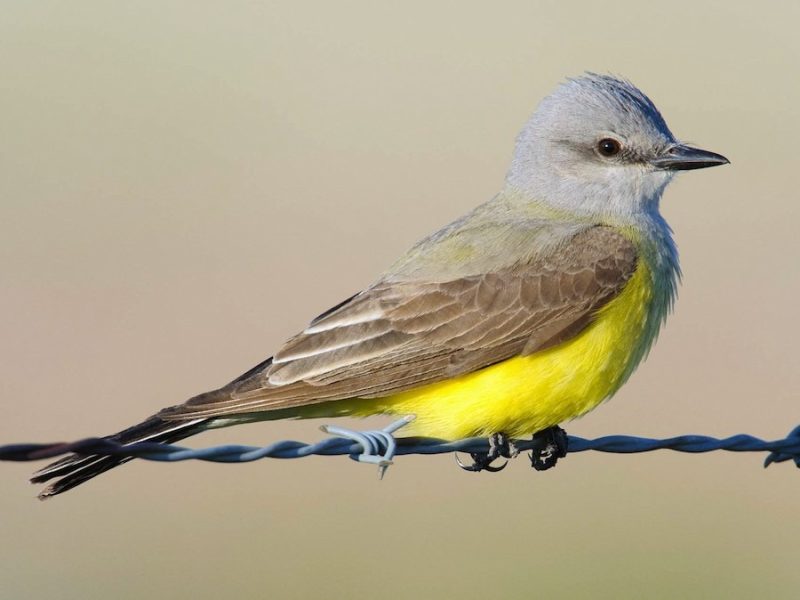
The Western Kingbird (Tyrannus verticalis) is a medium-sized flycatcher known for its soft gray upperparts, lemon-yellow belly, and contrasting white outer tail feathers. Its bold black tail and faint white chin add to its sharp, clean look. Measuring about 8.3 to 9.4 inches in length with a wingspan of up to 15 inches, this bird is agile and built for aerial hunting.
In Colorado, Western Kingbirds are common in open areas such as grasslands, agricultural fields, and roadside wires during the summer months. They are primarily insectivores and often perform impressive mid-air maneuvers to catch flying insects like grasshoppers, bees, and flies. They also eat small berries when insects are scarce. Their loud “kip-kip” calls are frequently heard as they defend their territories.
A fun fact: Western Kingbirds are highly territorial and will aggressively chase away larger birds—including hawks and crows—from their nesting area. Their fearlessness and aerial agility make them one of the more entertaining birds to observe in Colorado’s open country.
Western Tanager

The Western Tanager (Piranga ludoviciana) is a strikingly colorful songbird, with males boasting a bright yellow body, jet-black wings with white wing bars, and a fiery red-orange head during breeding season. Females are duller with yellow-green tones but still recognizable by their yellow plumage and wing markings. These tanagers are about 6.3 to 7.5 inches long with a wingspan up to 11.5 inches.
In Colorado, Western Tanagers are commonly seen in coniferous forests and mountain woodlands during spring and summer. They feed mainly on insects—often caught mid-air or plucked from leaves—and also consume berries and fruits. Despite their tropical appearance, they are tough birds that breed at surprisingly high elevations in the Rockies.
A fun fact: the male’s brilliant red head isn’t derived from carotenoids like most bird plumage but comes from rare rhodoxanthin pigments, believed to be obtained from their insect diet. This makes their coloring one of the rarest among North American birds.
Yellow‑headed Blackbird
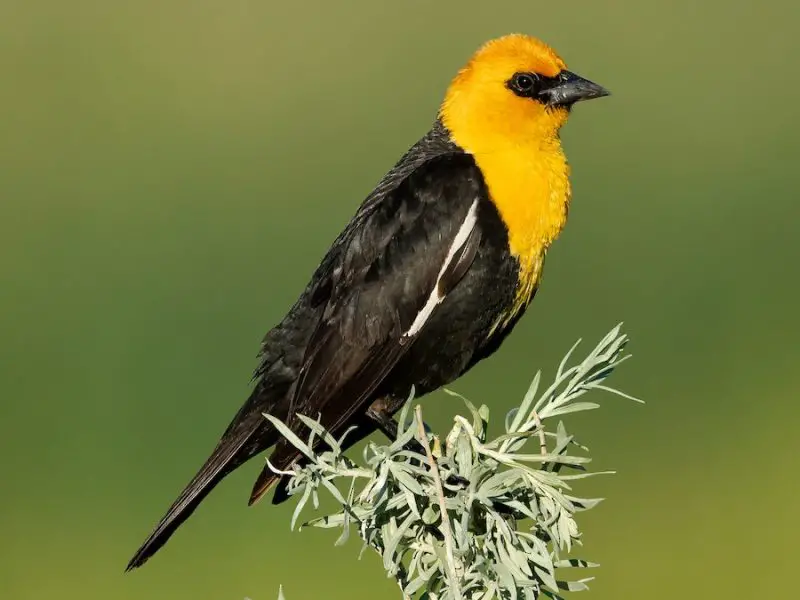
The Yellow-headed Blackbird (Xanthocephalus xanthocephalus) is an eye-catching marsh bird with a bold black body and a vibrant golden-yellow head and chest. Males are especially striking, while females have more muted brownish plumage with pale yellow throats. These birds are large for blackbirds, reaching 8.3 to 10.2 inches in length with a wingspan up to 17 inches.
This species breeds in wetland areas across Colorado, especially in cattail marshes and reedy ponds. They forage for insects, seeds, and grains, often in agricultural fields near their breeding grounds. Yellow-headed Blackbirds are colonial nesters, building their nests above water among dense vegetation. Males are known for their raspy, buzzing song, often described as mechanical or harsh.
Yellow-headed Blackbirds frequently form large post-breeding flocks with other blackbird species and can be seen flying en masse across Colorado’s plains and wetlands in late summer. Their sheer numbers and vibrant plumage make them a standout species during migration.
Common Yellowthroat
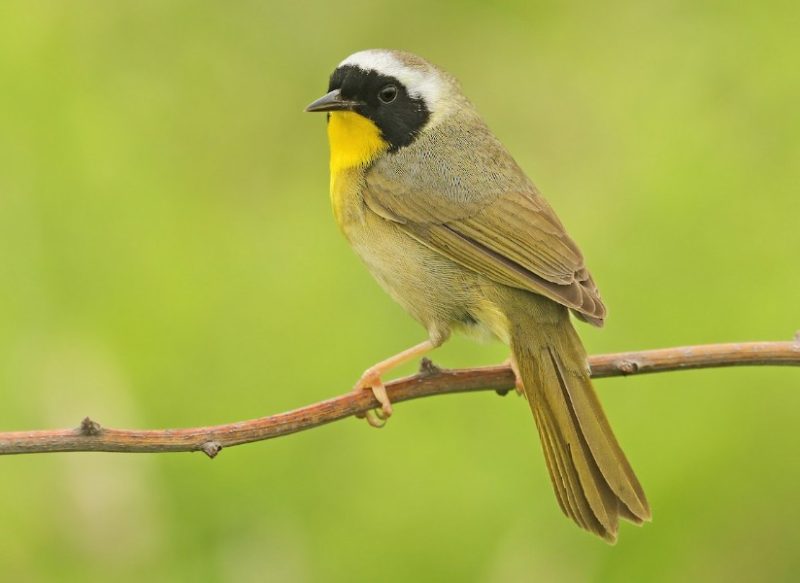
The Common Yellowthroat (Geothlypis trichas) is a small, secretive warbler easily identified by its bright yellow throat and underparts, and the bold black mask worn by males. Females lack the mask and are more uniformly olive-yellow. Measuring about 4.3 to 5.1 inches long with a wingspan of 6 to 7 inches, these birds are compact and often hidden in dense vegetation.
Common Yellowthroats are summer residents in Colorado, especially in marshes, wet meadows, and riparian thickets. They forage close to the ground for insects, spiders, and other small invertebrates. Their sharp “wichity-wichity-wichity” song is often heard before the bird is seen, as they skulk through thick reeds and shrubs.
One fascinating behavior of this species is its strong response to song playback. Males are especially territorial and will quickly approach and sing in response to recorded songs. Their curious and defensive nature makes them popular targets for birdwatchers hoping to catch a glimpse in Colorado’s wetlands.
Orchard Oriole

The Orchard Oriole (Icterus spurius) is a small, sleek bird known for its chestnut and black plumage in males and bright yellow-green tones in females and immatures. Males have a black hood, back, and tail, while the rest of their body is a rich reddish-brown. Females, which are more commonly seen in Colorado, have a yellowish chest and face with olive backs and two pale wing bars. These orioles range from 5.9 to 7.1 inches in length with a wingspan of about 10 inches.
Orchard Orioles pass through eastern Colorado during spring and summer, favoring open woodlands, river edges, and orchards. They forage for insects, spiders, nectar, and fruit, often seen darting among tree branches or hovering to pick food from leaves. Their woven hanging nests are built in trees or shrubs, suspended from slender branches and lined with soft grasses.
A fun fact about Orchard Orioles is that they are the smallest oriole species in North America. Despite their size, their melodic and whistled song carries well across open landscapes, making them easier to detect even when concealed in foliage.
Dickcissel
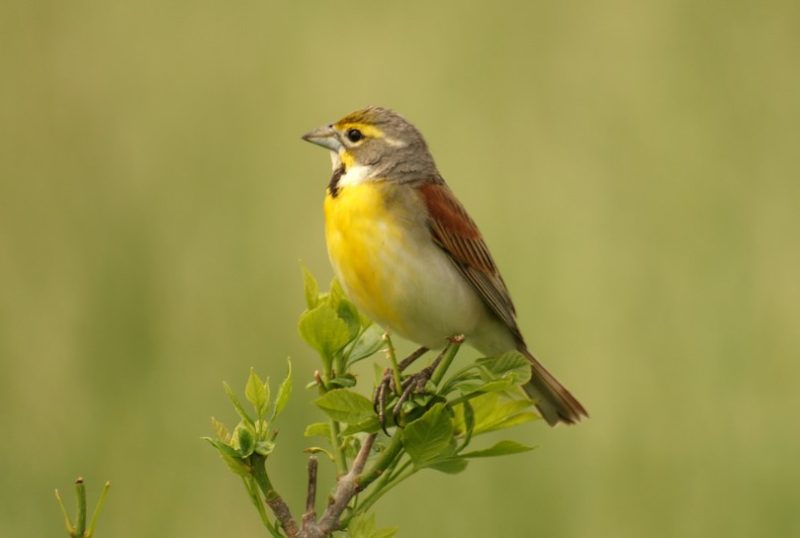
The Dickcissel (Spiza americana) is a sparrow-like bird with a distinctive appearance: a bright yellow breast, black throat patch, and chestnut shoulders. Males are bolder in coloration, while females and young birds are more subdued, showing streaky brown patterns with some yellow on the chest. Adults typically measure about 5.5 to 6.3 inches long with a wingspan around 9.8 inches.
In Colorado, Dickcissels are primarily summer visitors in the eastern plains and grasslands. They prefer tall grassy fields, weedy pastures, and prairies for both foraging and nesting. Their diet consists of seeds and insects, and they are often seen singing from fence posts or the tops of shrubs during the breeding season. Their repetitive song sounds like “dick-dick-cissel,” from which they get their name.
Dickcissels are known for their erratic migration patterns. Some years they appear in large numbers in Colorado, while in others they are scarce. This variability makes spotting one an exciting event for birdwatchers in the region.
Hooded Warbler
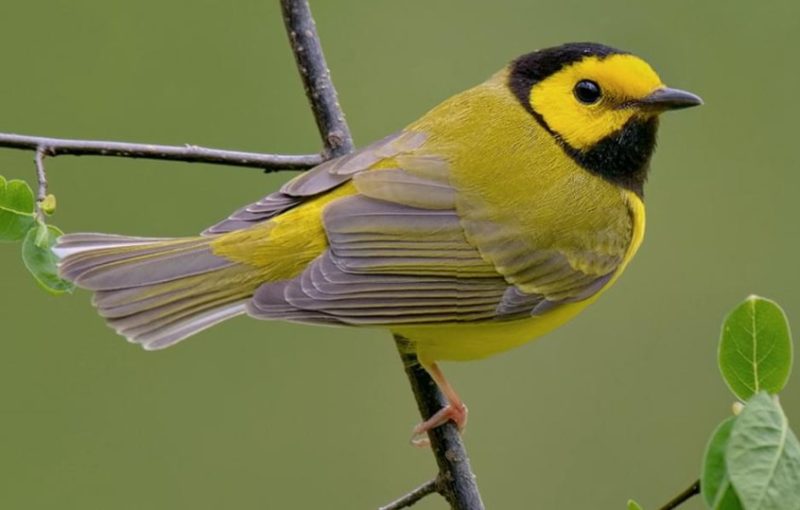
The Hooded Warbler (Setophaga citrina) is a striking forest warbler with a rich yellow face and underparts contrasted by a bold black hood and throat in males. Females and immature birds have a similar yellow body but lack the full black hood. This bird is small and active, measuring about 5.1 inches in length with a wingspan of around 6.9 inches.
Though uncommon, Hooded Warblers can occasionally be spotted in eastern Colorado during migration, especially in wooded riparian corridors or dense shrubby areas. They feed on insects such as caterpillars, beetles, and flies by hopping through low vegetation and sometimes catching prey in flight. Their sharp “ta-wit ta-wit ta-wee” song is distinct and can help locate them even when hidden.
Hooded Warblers have an interesting foraging behavior called “tail flashing,” where they fan and flick their white outer tail feathers to startle insects into movement, making them easier to catch. This flicking motion is a good identification clue when birding in dense understory habitats.
Yellow-throated Vireo

The Yellow-throated Vireo (Vireo flavifrons) is a colorful member of the vireo family, with olive-green upperparts, a bright yellow throat and chest, white belly, and two bold wing bars. It has a stout bill and slightly hooked tip, adapted for gleaning insects. This bird is about 5.1 to 5.9 inches long, with a wingspan of up to 9.8 inches.
In Colorado, Yellow-throated Vireos are rare but can be found during spring migration or as occasional breeders in mature deciduous woodlands. They forage methodically in the canopy, picking insects and spiders from leaves and twigs. Their song is a slow, burry series of phrases, sounding like “three-eight…ree-eight,” repeated steadily from high perches.
Yellow-throated Vireos are among the more colorful vireos, sometimes mistaken for warblers due to their vivid appearance. Their slow and deliberate movements, however, set them apart from the more energetic warbler species.
Scott’s Oriole
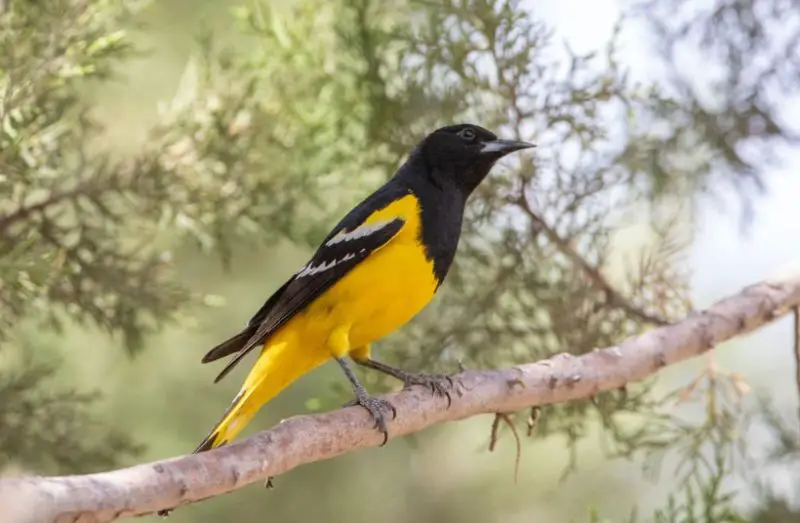
Scott’s Oriole (Icterus parisorum) is a large, boldly patterned oriole with a lemon-yellow belly and undertail, contrasted by a black head, chest, and back in males. Females are more muted with olive upperparts and paler yellow below. This striking bird ranges from 9.1 to 9.8 inches in length and has a wingspan of about 13 inches.
In Colorado, Scott’s Orioles are mostly found in the southern parts of the state, particularly in open pinyon-juniper woodlands, canyon slopes, and desert scrub. They feed on insects, nectar, and fruit, often foraging high in trees or near yucca plants, where they sometimes nest. Their sweet, flutelike song is slow and melodic, often heard at dawn.
A fascinating behavior of Scott’s Orioles is their relationship with yucca plants. They are known to nest in the fibrous leaves of tall yuccas, using the plant’s fibers in their nest construction and sometimes even feeding on yucca nectar or insects hiding in the blooms.
Yellow-rumped Warbler
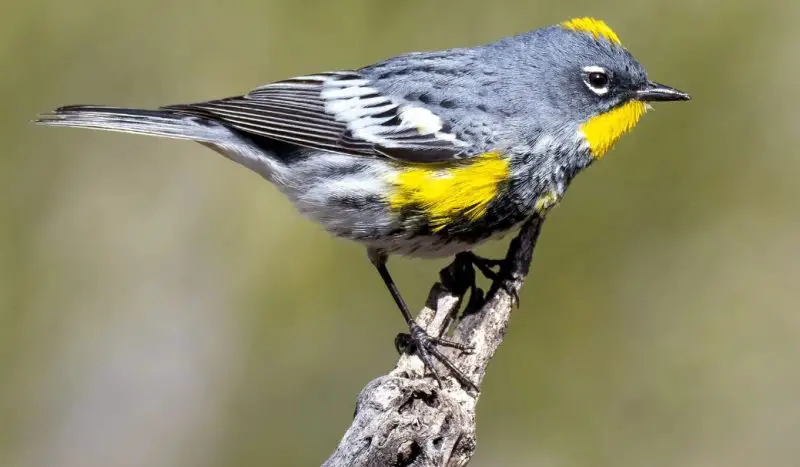
The Yellow-rumped Warbler (Setophaga coronata) is a versatile and widespread warbler, easily recognized by the bright yellow patches on its rump, sides, and crown. There are two main forms: the “Audubon’s” variety, common in the western U.S., has a yellow throat, while the “Myrtle” form has a white throat and is more common in the east. These warblers are small, measuring around 4.7 to 5.9 inches long with a wingspan of up to 9.1 inches.
In Colorado, Yellow-rumped Warblers are abundant during migration and summer in coniferous forests and mountain woodlands. Unlike many warblers, they can digest waxes in berries such as those of bayberry and juniper, which allows them to winter farther north. During warmer months, they primarily feed on insects, catching them in flight or picking them from foliage.
One unique trait of this species is its adaptability. The Yellow-rumped Warbler is often the first warbler to return in spring and the last to leave in fall, thanks to its varied diet and tolerance of cooler temperatures.
Wilson’s Warbler
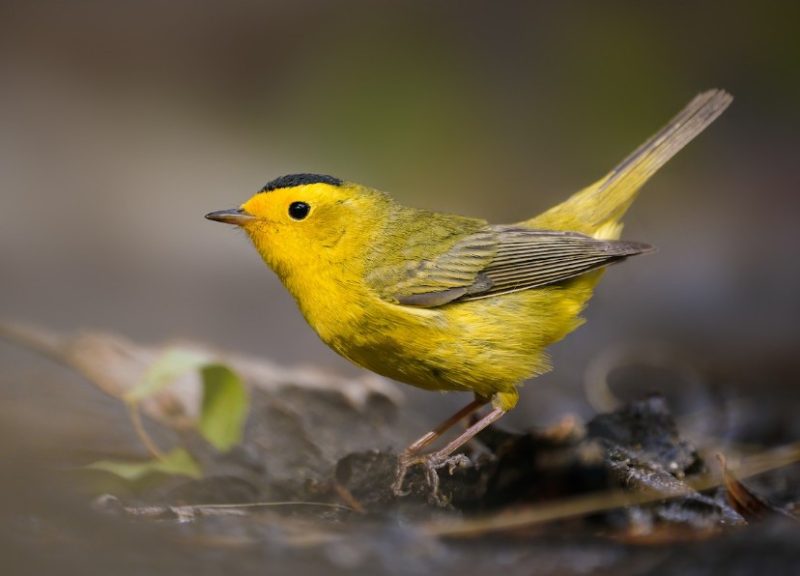
Wilson’s Warbler (Cardellina pusilla) is a cheerful little bird with a bright yellow body and a distinctive small black cap on adult males. Females and young birds have a similar yellow appearance but with a much fainter or absent crown. It is one of the smaller warblers, measuring only 4.3 to 5.1 inches in length with a wingspan of around 6.7 inches.
In Colorado, Wilson’s Warblers are common migrants and breeders in montane riparian areas, alder thickets, and willow-lined streams. They are active insectivores, flitting through shrubs and low trees in constant motion as they search for caterpillars, beetles, and flies. Their song is a quick, chattering series of notes, and their call is a sharp “chit.”
Wilson’s Warblers are known for their friendly and inquisitive nature. Unlike many warblers that stay hidden, these birds often come close to observers, making them a favorite among birdwatchers in Colorado’s high-country habitats.
Orange-crowned Warbler
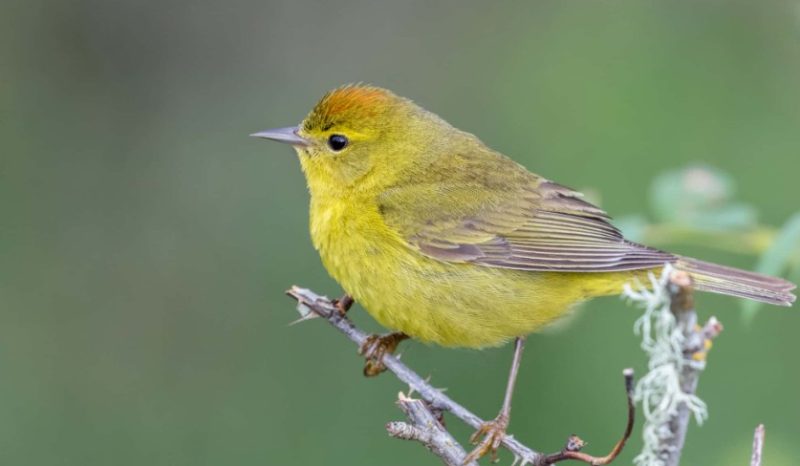
The Orange-crowned Warbler (Leiothlypis celata) is a subtly colored warbler, often overlooked due to its plain olive-yellow appearance. Despite its name, the orange crown is rarely visible, usually hidden beneath feathers and only occasionally flared during display or agitation. This small warbler is about 4.3 to 5.5 inches long with a wingspan near 7.5 inches.
In Colorado, Orange-crowned Warblers pass through during spring and fall migration, and some breed in brushy habitats at higher elevations. They forage in low shrubs and deciduous trees, searching for insects, spiders, and occasionally berries. Their soft trill of a song is gentle and often blends into the background of woodland sounds.
A fascinating feature of this species is its geographic diversity. Several subspecies exist, each with slightly different coloration and migratory behavior, and Colorado may host multiple forms depending on the season.
American Redstart
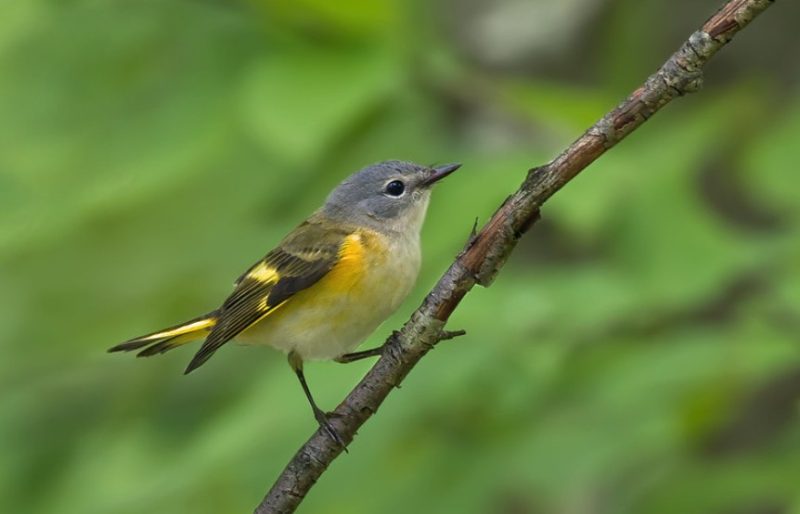
The American Redstart (Setophaga ruticilla) is a flashy and energetic warbler, with adult males sporting black plumage set off by brilliant orange patches on the wings, tail, and sides. Females and immature males replace the black with olive-gray and the orange with vibrant yellow. These birds are about 4.3 to 5.1 inches long with a wingspan of up to 7.5 inches.
Though more common in the eastern U.S., American Redstarts are regular migrants through Colorado and breed in some riparian woodlands and foothill thickets. They are active foragers, constantly fanning their tails and flashing their wing patches to startle insects, which they then catch mid-air. Their lively behavior and sweet, whistling song make them easy to recognize.
An interesting fact is that male American Redstarts use their bright plumage to defend territories and attract mates. Older males with full black-and-orange plumage are more successful at securing the best breeding spots than younger, duller males.
Baltimore Oriole
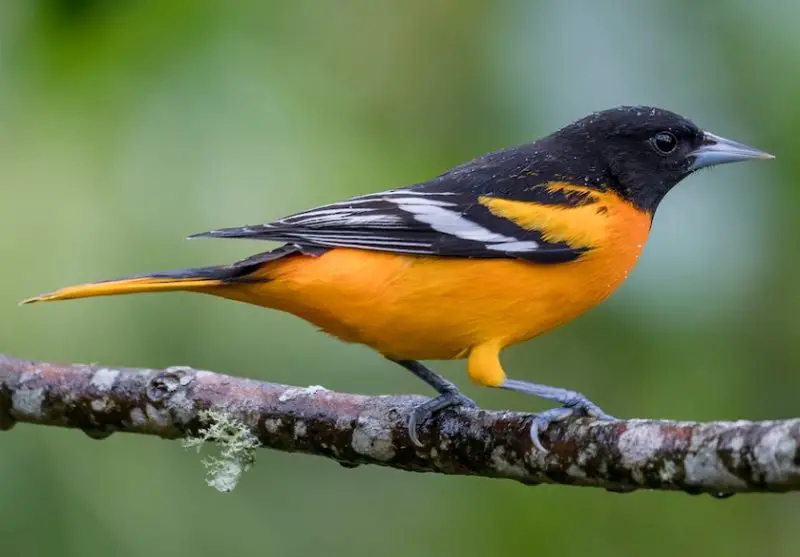
The Baltimore Oriole (Icterus galbula) is a dazzling member of the blackbird family, with adult males displaying fiery orange underparts and shoulders, jet-black backs and heads, and white wing bars. Females and immature birds are more yellow-orange with grayish backs. These striking birds are about 6.7 to 7.5 inches long and have a wingspan of up to 12 inches.
While more common in the eastern U.S., Baltimore Orioles are occasionally seen in eastern Colorado during spring and summer, especially near cottonwood groves, parks, and orchards. They feed on insects, fruit, and nectar, and they are frequent visitors to feeders offering oranges, jelly, or sugar water. Their nests are elaborate hanging pouches woven from plant fibers and string.
Baltimore Orioles are known for their rich, flute-like songs and sharp call notes. Their beauty and melodious voices make them one of the most beloved birds across their range, and spotting one in Colorado is always a treat.
Nashville Warbler
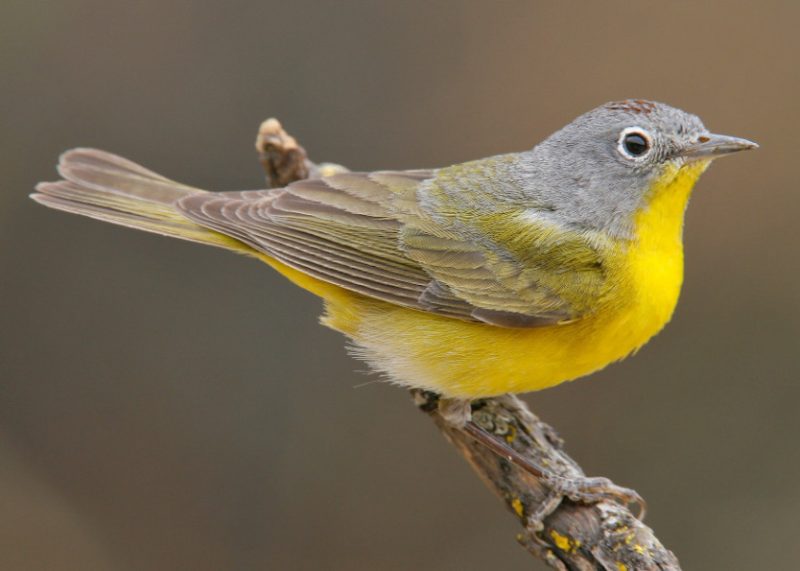
The Nashville Warbler (Leiothlypis ruficapilla) is a small, lively bird with olive-green upperparts, a bright yellow underside, and a contrasting white eye-ring. Adult males show a subtle rusty crown patch, which is usually hidden under their gray hoods. They are compact warblers, measuring about 4.3 to 5.1 inches in length with a wingspan of around 6.7 inches.
In Colorado, Nashville Warblers are seen primarily during spring and fall migration, especially in shrublands, woodland edges, and riparian areas. They forage by flitting through shrubs and low trees, picking insects from leaves and branches. Their sharp “tsip” call and high-pitched song help birders detect them as they move quickly through vegetation.
Despite the name, Nashville Warblers are not especially tied to Tennessee. The name comes from the city where the first specimen was collected, but their breeding range is mainly in the northern U.S. and Canada, and they regularly stop in Colorado during their long migratory journey.
Summer Tanager
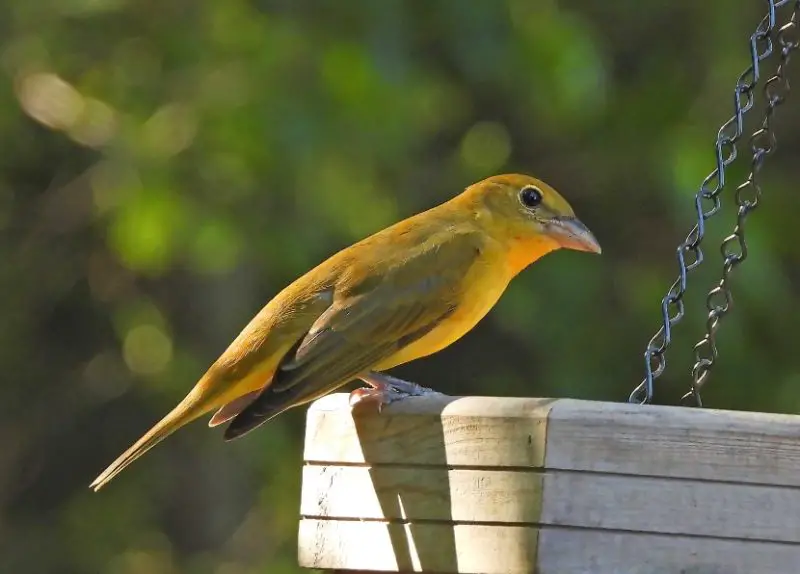
The Summer Tanager (Piranga rubra) is known for its solid coloring—males are entirely rosy red, while females and immatures are mustard yellow with olive wings. Unlike other tanagers, their coloration is mostly uniform and lacks streaks or wing bars. These medium-sized songbirds are about 6.7 inches long with a wingspan of 11 to 11.8 inches.
Summer Tanagers are found in southeastern Colorado during the breeding season, especially in open woodlands with oaks or cottonwoods. They feed primarily on bees and wasps, which they catch mid-air and beat against branches to remove stingers. They also consume fruit and are occasionally seen visiting backyard feeders with sliced oranges.
A fascinating trait of the Summer Tanager is its ability to safely eat stinging insects. It is sometimes nicknamed the “bee bird” because of its diet, and its red color makes it one of the few all-red songbirds in North America.
Palm Warbler

The Palm Warbler (Setophaga palmarum) is a distinctive warbler with a yellow belly, brownish back, and a rusty-red crown that stands out in spring. They are easily recognized by their constant tail bobbing, a behavior few other warblers display. These small birds measure about 4.7 to 5.5 inches long with a wingspan up to 8.3 inches.
In Colorado, Palm Warblers are uncommon migrants, typically seen in weedy fields, open woodlands, and brushy edges during spring and fall. They forage on or near the ground, searching for insects and small invertebrates. Their habit of flicking their tails while walking helps birders quickly identify them even from a distance.
Despite their name, Palm Warblers rarely associate with palm trees. The name comes from their discovery in the Caribbean, but their breeding grounds are in boreal bogs of Canada, and they can appear in surprising places like Colorado during migration.
Magnolia Warbler
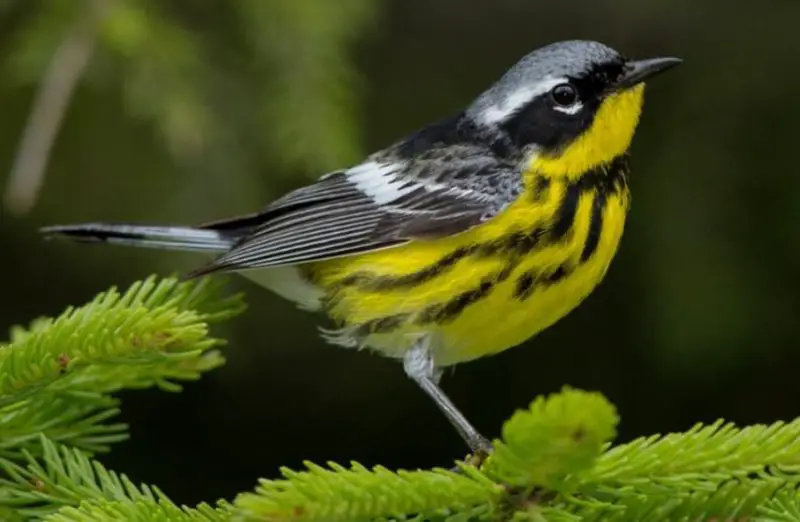
The Magnolia Warbler (Setophaga magnolia) is a stunning warbler with a bold yellow breast streaked with black, a black mask, and a white wing patch. Males are more vibrant, while females and juveniles have duller colors but still retain the yellow underparts and dark tail band. These birds are about 4.3 to 5.1 inches long, with a wingspan of up to 7.9 inches.
Magnolia Warblers are seen in Colorado primarily during migration. They prefer dense thickets, spruce edges, and low shrubs, often foraging close to the ground. They feed on caterpillars, spiders, and flies, sometimes hovering to pluck prey from foliage. Their song is a short, sweet series of rising notes, often heard in spring.
Although their name suggests an association with magnolia trees, this species was named after one being collected in a magnolia grove in Mississippi. They actually breed in northern coniferous forests and just pass through Colorado during spring and fall.
Blue-winged Warbler
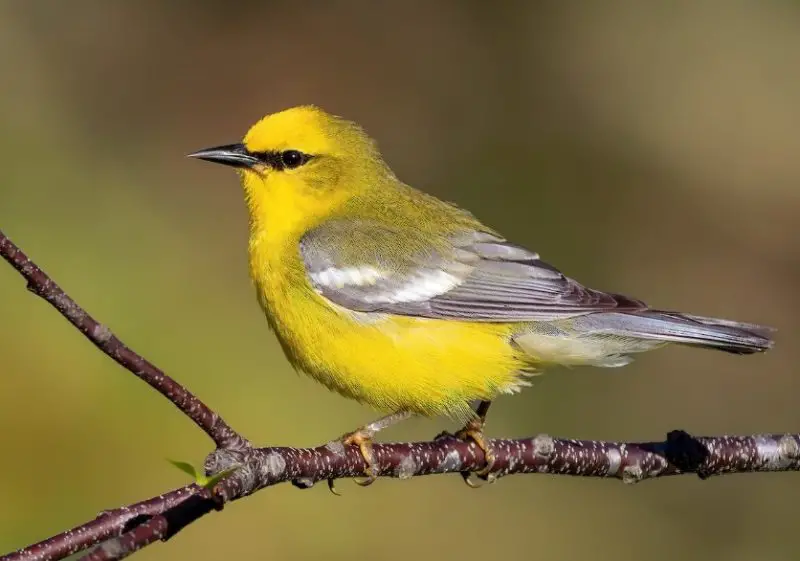
The Blue-winged Warbler (Vermivora cyanoptera) is a sleek warbler with lemon-yellow plumage, slate-blue wings with white wing bars, and a sharp black line through the eye. Its clean coloring and slightly curved bill make it easy to identify among other warblers. It measures about 4.3 to 4.7 inches long with a wingspan of 6.7 inches.
Blue-winged Warblers are rare migrants in Colorado but are sometimes spotted in dense shrubby areas and young woodlands during spring and fall. They forage low in the understory for caterpillars, beetles, and other insects. Their distinctive buzzing song, often transcribed as “bee-buzz,” is usually delivered from perches hidden in brush.
This species is known to hybridize with the Golden-winged Warbler, producing two well-known hybrids: Brewster’s and Lawrence’s Warblers. These hybrids can occasionally turn up in unexpected places like Colorado, making sightings especially exciting.
Prothonotary Warbler

The Prothonotary Warbler (Protonotaria citrea) is a brilliant golden-yellow bird with a blue-gray back, olive-tinged wings, and dark eyes set in a glowing face. Males are especially vibrant, while females are slightly paler but still beautiful. This species is around 5.1 inches long with a wingspan of about 8.3 inches.
Though more typical of the southeastern U.S., Prothonotary Warblers are rare vagrants in Colorado, usually seen near ponds, slow-moving streams, or marshes during migration. Unlike most warblers, they nest in cavities—often in dead trees or nest boxes near water. Their foraging involves creeping along branches and probing bark crevices for insects and snails.
Their name comes from the yellow-robed clerks of the Catholic Church—the “prothonotaries.” These warblers live up to the name with their golden appearance and are a sought-after species for Colorado birders during spring and fall migration.
Black-throated Green Warbler

The Black-throated Green Warbler (Setophaga virens) is a striking forest warbler with a yellow face, olive-green back, and bold black throat and chest in males. The underparts are mostly white with some dark streaking, and the wings feature two clear white bars. They are around 4.3 to 5.1 inches long with a wingspan of 7.9 inches.
In Colorado, Black-throated Green Warblers are uncommon migrants that occasionally appear in wooded riparian zones and coniferous areas. They forage by picking insects from leaves and twigs high in the canopy, often moving slowly and deliberately. Their song is a buzzy “zee-zee-zee-zoo-zee,” often repeated from one perch for minutes at a time.
These warblers breed in northeastern conifer forests but wander widely during migration. Their distinct appearance and unique song make them a memorable find for birders lucky enough to spot one passing through Colorado.
FAQs About Yellow Birds in Colorado
What is the most common yellow bird in Colorado?
The American Goldfinch is considered the most common yellow bird in Colorado, especially during the summer months. With its bright yellow plumage and cheerful song, it’s a frequent visitor to backyards, fields, and open woodlands.
Are there yellow birds in Colorado during the winter?
Yes, some yellow birds like the Cedar Waxwing and Lesser Goldfinch may remain in parts of Colorado during the winter, depending on food availability and weather conditions. However, many vibrant yellow warblers and orioles migrate south for the season.
Do yellow birds come to backyard feeders in Colorado?
Absolutely. Birds such as American Goldfinches and Lesser Goldfinches are attracted to feeders with thistle (nyjer) or sunflower seeds. Placing feeders near trees or shrubs also helps attract more yellow birds to your yard.
What time of year can I see the most yellow birds in Colorado?
Late spring through early fall is the best time to spot yellow birds in Colorado. Many species migrate through or nest in the state during this period, including warblers, tanagers, and orioles.
Are all yellow birds in Colorado truly yellow?
Not entirely. Some birds, like the Western Tanager or the Yellow-rumped Warbler, have patches of yellow mixed with other colors such as black, gray, or red. The intensity and placement of yellow feathers can vary widely between species.
Where should I look for yellow birds in Colorado?
Yellow birds can be found in a variety of habitats across Colorado, including woodlands, grasslands, riverbanks, and even suburban gardens. State parks and wildlife refuges like Rocky Mountain Arsenal or Barr Lake are excellent birdwatching spots.
How can I tell yellow warblers apart?
Yellow warblers can be challenging to identify because of their similar coloring and quick movements. Paying attention to specific features like eye rings, wing bars, and throat markings can help differentiate between species like the Yellow Warbler, Wilson’s Warbler, and Orange-crowned Warbler.
Are yellow birds a sign of anything culturally?
In many cultures, yellow birds symbolize joy, positivity, and spiritual messages. Seeing a yellow bird is often interpreted as a sign of happiness, hope, or good luck, especially in folklore and dreams.
What foods attract yellow birds?
Yellow birds are often attracted to black oil sunflower seeds, thistle (nyjer) seeds, fruit, and nectar. Orioles, for example, enjoy orange slices and grape jelly, while goldfinches prefer seeds from native wildflowers and feeders.
Can I see both Eastern and Western species of yellow birds in Colorado?
Yes, Colorado is uniquely situated in a transition zone between eastern and western North America, so it occasionally hosts both Eastern and Western species, especially during migration. This overlap can provide excellent opportunities for birdwatchers.

